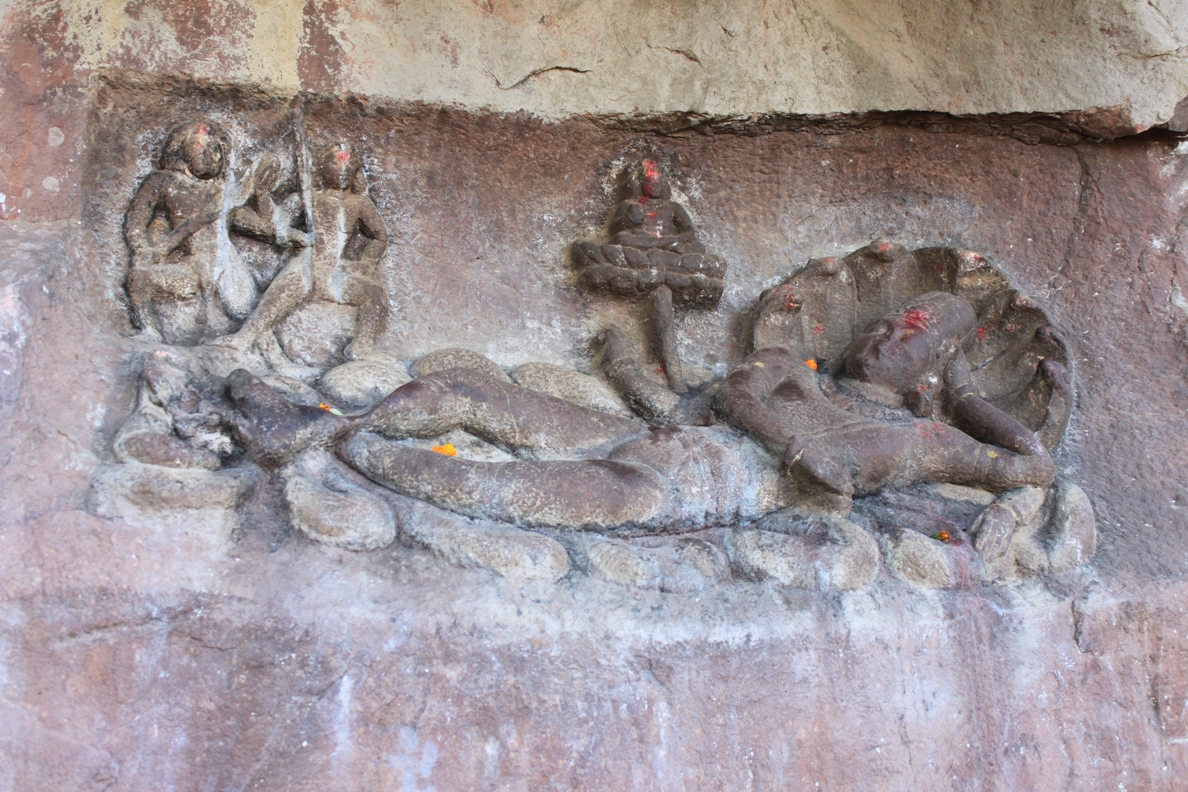Sindursi is a small village near Bahoriband in the Katni district of Madhya Pradesh. The rock-cut sculptures in the village were discovered in 1960-61 by C B Trivedi.1
Jogia Baba ka Sthan or Katav – This rock-cut sculpture group is under the protection of the Department of Archaeology and Museums, Madhya Pradesh. The sculptures are generally assigned to the Gupta period of the 4th-5th century CE, this dating is also supported looking at the sculptural style and iconography.
Sheshashai Vishnu – Vishnu rests on the coil-bed of Shesha with his head under the canopy formed by seven hoods of Shesha. Vishnu is four-armed, one arm below his head and two arms patting the coils, while one lower right arm is raised up such as holding some attribute, the latter is not clear. Bhu-Devi is shown seated next to his feet, caressing his soles. Brahma emerges seated over a lotus from the navel of Vishnu. Brahma is shown with his three heads and two arms. Two demons, Madhu and Kaitabha, are shown approaching the feet of Vishnu, one carrying a sword and another holding a club.
Standing-Vishnu – This four-armed image of Vishnu is shown standing in sambhanga posture. His two lower hands rest over the personified ayudhas, a female gada (club) named Kaumaudiki and a male chakra (discus) named Sudarshana. The ayudhas are shown standing on the back side of the respective figure. The upper right-hand holds a shankha (conch) and the upper left hand is in varada-mudra. He wears a long vanamala (garland) reaching below his knees.
Mahishasuramardini – The goddess is shown with four hands in the act of slaying the demon Mahishasura. She has trapped the demon under her right foot, and her trishula, held in her upper left hand, has pierced the body of Mahishasura, while her upper left hand holds the tail of the demon. Mahishasura is shown in his zoomorphic form. In her lower two hands, she is holding a shield and a sword.
Narasimha – Narasimha is shown seated in maharajalilasana, with one leg raised and another resting flat on the seat. Narasimha is not shown carrying any attributes in his two arms. Two examples of very similar iconography, belonging to the Vakataka period of the 5th century CE, have been found in Ramtek, Maharashtra.
1 Indian Archaeology 1960-61 – A Review. p. 60
Acknowledgment: Some of the photos above are in CC0 1.0 Universal Public Domain from the collection released by the Tapesh Yadav Foundation for Indian Heritage. Some of the photos above are in CC0 1.0 Universal Public Domain from the collection released by Tapesh Yadav Foundation for Indian Heritage.


Very fine, as usual. I have the Narasimha if you’d like it.
Comments are closed.